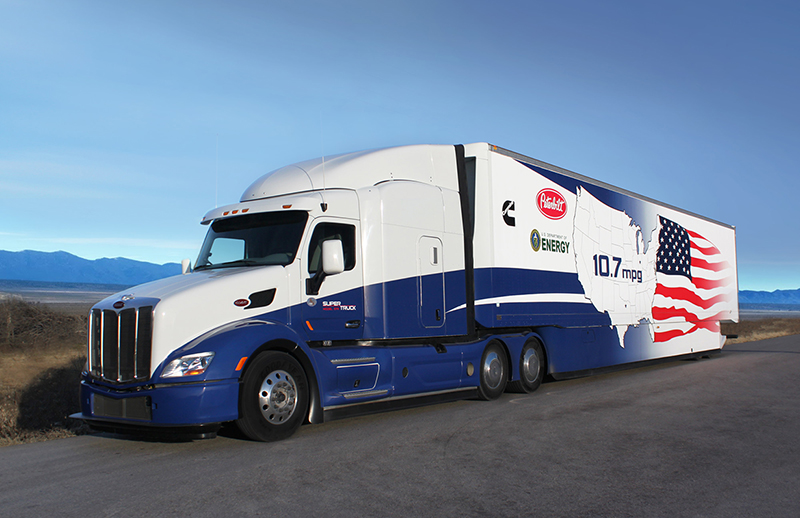SuperTruck II team reaches never achieved before 55% brake thermal efficiency
By Catherine Morgenstern, Brand Journalist

The U.S. Department of Energy (DoE) recently recognized the Cummins SuperTruck II team for pioneering research and development in heavy-duty diesel engine technology. This honor, which was presented to the team during the DoE’s Annual Merit Review Conference, celebrates their achievement of 55% brake thermal efficiency (BTE) from an engine equipped with waste heat recovery, an important metric in the SuperTruck II program. The conference was held on June 21.
"Getting to 55% BTE was about optimally moving the needle in many areas. The interactions among the engine subsystems complicated defining how to operate each of these subsystems to reach the optimum engine performance. Achieving the final objective occurred with careful hardware selection and a month of optimization of the engine and Waste Heat Recovery systems at the test cell," said Jon Dickson, Cummins Principal Investigator for the SuperTruck II initiative. "There were a lot of people at Cummins that came together to make this happen, who never gave up even when we were down to the wire, and I’m thrilled to accept this award in recognition of their perseverance."
Cummins has been part of the DoE’s SuperTruck initiative since it began in 2010 with the goal to improve heavy-duty truck freight efficiency. BTE quantifies the fraction of the fuel's chemical energy that is converted into useful work by the engine system, and acts as an important measurement of overall engine efficiency. As the SuperTruck II program progresses, the Cummins engine with 55% BTE will integrate into a Peterbilt truck to ultimately demonstrate improvement in freight efficiency.
"All of this invention did not happen solely during the SuperTruck II project—in fact, a lot of this work was set in motion with SuperTruck I," added Tim Shipp, Engine Performance Leader for the Cummins SuperTruck II team.
"The challenge of SuperTruck I allowed us those years to focus on improving efficiency, and Cummins hasn’t stopped pressing forward since then. Everything we have learned ties so closely together, and reaching 55% BTE is the culmination of all that focused activity."
More than 200 Cummins employees supported the core SuperTruck team of 25 innovators, who inched toward the 55% BTE goal with incremental changes and improvements until finally, on a cold evening in January, they reached their goal.
Mr. Shipp adds, "When it was game time during those last months, the pressure was on to find the technology to push us to the finish line. That is where the team’s persistence really came into play, but also the company’s commitment to innovation. Without a real desire to deliver on this experiment from the team and company leadership, we never would have gotten there."

In his testimony to the United States Senate in March of this year, Cummins Vice Chairman Tony Satterthwaite confirmed the company’s commitment to developing the technologies of tomorrow, and the importance of industry and government partnerships such as SuperTruck.
"The heavy-duty and non-road vehicle industry is undergoing significant change, and Cummins is leading the way by investing and innovating in a broad portfolio of power including advanced diesel, natural gas, hybridization, electrified power, fuel cell technology and alternative fuels –so our customers can have the right solution to get the job done," Satterthwaite said. "However, industry working alone will not get us where we need to be in a time frame that is feasible. Government supported innovation is needed to meet our global energy and environmental challenges."
When the technologies developed under the SuperTruck I initiative hit the market, they are projected to save 7.9 million gallons of diesel fuel per day and reduce CO2 emissions by 33% from the 2009 baseline. SuperTruck II demonstrates a further 50% reduction in CO2 emissions, doubling efficiency.
Daniel Mohr, System Integration Lead for the Cummins SuperTruck project, is excited to keep building on the team’s success. “We set out to meet aggressive engine-level targets, but we will not meet all our goals simply by increasing engine efficiency; we need to think about investigating the use of low carbon fuels-- hydrogen, natural gas, and alcohols. This is our next focus.”
Cummins’ quest for engine efficiency doesn’t end with 55% BTE.
"Greater engine efficiency is still feasible, and our work will continue toward that goal,” said Dickson. "While we are all thrilled to celebrate this SuperTruck II achievement, we will continue to push ourselves to meet the needs of our customers and our planet."
Author Profiles

Catherine Morgenstern, Brand Journalist
Catherine Morgenstern is a Brand Journalist for Cummins, covering topics such as alternative propulsion, digitalization, manufacturing innovation, autonomy, sustainability, and workplace trends. She has more than 20 years of experience in corporate communications, holding leadership positions most recently within the Industrial Capital Goods sector. Catherine began her career as a marketing writer for a biotechnology company, where she learned to take complicated and highly technical information and make it accessible to everyone. She believes the concept of “storytelling” is more than a trendy buzzword and loves to find ways for her readers to make personal connections to her subjects. Catherine has a passion for technology and innovation and how its intersection can make an impact in all our lives. Catherine recently moved back to her hometown in the Hudson Valley, New York after a several decades in Los Angeles and Chicago. She is a graduate of UCLA and enjoys gardening and spending time with her husband and three children.
Related Tags